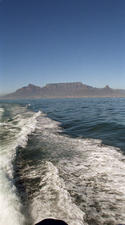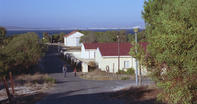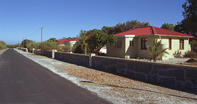The Ferry Ride

A highlight of the Robben Island tour is the actual boat ride over to the island. The ferry takes about 30 minutes each way, and the views of Cape Town and Table Mountain are superb.
In fact, every passenger seems to be hanging off the ferry with their cameras and cell phones in a vain attempt to capture the colossal vista.
Video cameras are also very prevalent, and every journey of the ferry is captured in its entirety by at least a dozen videographers – probably making it the most documented boat ride in the world.
Do note, however, that the seas can get rough and crossing may be cancelled if the weather is unsuitable. The two ferries currently in service carry about 160 people at a time, so they are always full.
This results in a bit of pushing and shoving, particularly when the swells are high and people stagger from one side of the boat to the other in order to take in the view.
The ferries have a kiosk which sells snacks and drinks, but food is not prepared on the boat.
Beer is not sold on the way to the island, but it is served on the way back. In any event, after a fantastic journey across the channel from Cape Town, the ferry docks at Murray’s Harbour on Robben Island.
Visitors then disembark and walk past towering black and white pictures of the island’s past, towards the waiting busses.
The Bus Tour

When getting off at the island, a bus tour follows. The bus does not stop anywhere for long, and you are not allowed to get off the bus to explore. There is only a limited time available and a large number of people to process.
Furthermore, there is a community of 150 people living on the island, and their lives would be greatly disrupted by a constant stream of strangers strolling through their village. As it is, the busses drive past with such regularity that the local children walking home from school have grown accustomed to the gawping faces that peer out of the passing windows.
In the future, the Robben Island Museum is planning to inaugurate a walking tour of the island and, perhaps, a mountain bike route. When these become available, it is heartily recommended that you take up the offer. You really have to tread on the soil of Robben Island to experience the power of the place.
Robert Sobukwe’s house

When leaving the harbour, you pass through the concrete portals that bear the island logo (a lily) and the apartheid-era prison motto, ‘We serve with pride. Ons dien met trots”. A military gun post from World War II is briefly visible to your left, and the main bulk of the maximum-security prison looms up ahead.
The bus continues to the left, however, dodging the penguins, and soon pulls up alongside an old cemetery, quite close to the prison walls. This is the old lepers’ cemetery, and the crumbling graves seem to ring with the pathos of their mournful inhabitants. The next stop is Robert Sobukwe’s house, set a short distance apart from the village.
The tiny two-roomed house looks very small to have housed a big personality like Sobukwe, but it was here that he lived for nine years with almost no human contact. The dog kennels alongside the house were added in 1976, after the Soweto Riots, when additional attack dogs were brought in to help subdue the feisty new arrivals.
The bus continues on to the Church of the Good Shepherd. This simple, whitewashed structure was designed by Sir Herbert Baker as a place of worship for the people living with leprosy, who were then resident at the General Infirmary. It had no pews and very small windows, so that the disease wouldn’t infect the other inhabitants. It was built in 1895 and is a national monument.
Drive Through the Village
You now drive through the village, also known as the Irish Town. It is a mixed bag of buildings. Some date from the Victorian era when the island was a hospital, others date from the military years during the Second World War. There are also several newer structures built for the community of warders that lived here with their families when it was still an apartheid prison.
These later buildings tend to be as humourless and dull as the Nationalist politicians of the time, and the compound built for the unmarried white guards is particularly horrible, although still much better than a jail cell. As part of their commitment to heritage management and preservation, all of the buildings on Robben Island are kept in a more-or-less original condition.
The paint is allowed to peel and renovations are not allowed, apart from those improvements which are necessary to keep the buildings standing. This is entirely appropriate for a museum, but it does make life somewhat unusual for the people who live and work here.
The Admin building, for example, is built around an unpainted concrete courtyard and is still strongly reminiscent of the old prison offices that they once were. Even in the village, things are not allowed to be changed, and the old asylum for female lunatics still stands, empty and abandoned, shrieking with a mute misery.
By David Fleminger